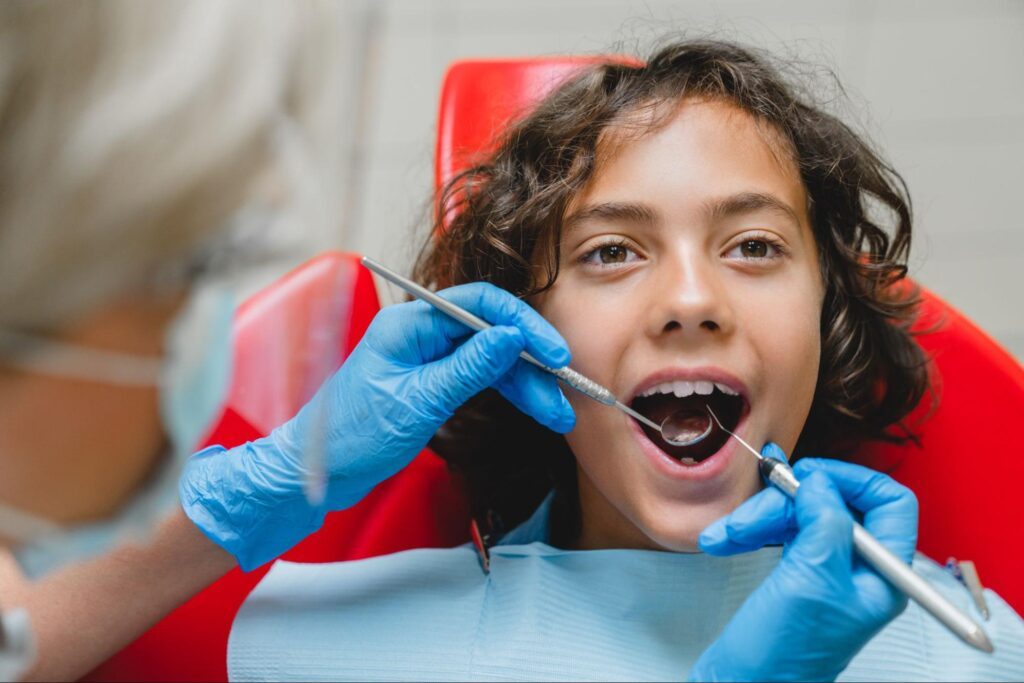Parents often wonder when the right time is to take their child to the orthodontist. While most people think orthodontic treatment begins in the teenage years, many issues can be identified and corrected much earlier. Interceptive orthodonticsis the term for treatment that takes place while your child’s mouth and jaws are still developing.
At New England Orthodontic Specialists, Dr. Diana Esshaki, Dr. Neil Flückiger, and their expert team provide early evaluations to help guide proper growth and ensure healthy development for every smile. With offices in Beverly, Topsfield, South Hamilton, Salem, and Lynn, we’re committed to helping your child’s smile grow healthy and beautiful!
What Interceptive Orthodontics Means
Interceptive orthodontics, also called Phase I treatment, involves diagnosing and addressing orthodontic issues before all the permanent teeth come in. This type of early care focuses on guiding jaw growth, improving bite relationships, and preventing crowding or misalignment that might otherwise become more complex later.
According to the American Association of Orthodontists (AAO), children should have their first orthodontic evaluation by age seven. At this age, an orthodontist can see how the jaws are developing and how the permanent teeth are likely to erupt. Identifying concerns early doesn’t always mean treatment begins right away, but it provides valuable insight for long-term planning.
Why Early Evaluation Matters
During the ages of six to eight, children usually have a combination of baby teeth and newly erupted adult teeth. This mix gives orthodontists a clear view of emerging patterns that could indicate future alignment or spacing problems.
At this stage, orthodontists like Dr. Esshaki and Dr. Flückiger look for:
- Early signs of crowding or spacing issues
Crossbites, underbites, or open bites - Jaw growth discrepancies between the upper and lower arches
- Tooth eruption problems caused by retained baby teeth or missing permanent ones
- Oral habits such as thumb sucking that affect bite development
Recognizing these factors early allows orthodontists to intervene only when necessary, using minimal, targeted treatment to guide natural growth.
How Interceptive Orthodontics Works
Interceptive orthodontics typically takes place between ages seven and ten, before all permanent teeth have erupted. Treatment can include a range of gentle approaches, depending on the child’s individual needs.
Common early treatments include:
- Palatal expanders:Widen the upper jaw to make space for incoming permanent teeth.
- Partial braces or limited aligners:Straighten a few teeth or adjust alignment for proper function.
- Space maintainers:Keep a gap open for a tooth that has not yet erupted after premature baby tooth loss.
- Functional appliances:Help guide the growth of the jaws to correct bite discrepancies.
Most Phase I treatments last 6 to 12 months and are followed by a resting phase, during which the orthodontist monitors growth and tooth eruption. Later, if needed, Phase II treatment with bracesor Invisalignis used to refine alignment once all adult teeth are present.
Problems Interceptive Orthodontics Can Help Prevent
Early orthodontic care is not just about appearance, but also about supporting healthy oral development. Interceptive treatment can prevent more complex problems from forming, including:
- Severe Crowding
When the jaw is too small to fit all the permanent teeth, early treatment can make space and reduce the need for extractions later. - Bite Misalignment
Issues such as crossbites or underbites can cause uneven wear on teeth or affect facial growth. Guiding jaw development early can minimize these effects. - Protruding Teeth
Front teeth that stick out too far are prone to injury. Correcting them early can reduce risk while improving function. - Premature or Delayed Tooth Loss
Losing baby teeth too early (or not losing them soon enough) can disrupt the proper path of permanent teeth. Interceptive orthodontics keeps development on track. - Habit-Related Problems
Thumb sucking, tongue thrusting, and mouth breathing can all affect bite and jaw growth. Early orthodontic attention can help children break these habits and restore balance.
By addressing these concerns early, interceptive orthodontics can simplify future treatment, often shortening the time needed for braces or aligners later on.
The Role of Growth and Development
Children’s jaws and facial bones are still growing, which means orthodontists can use this natural growth to their advantage. Interceptive orthodontics takes advantage of this period of flexibility, gently encouraging the jaws and teeth to develop in harmony.
For example, widening the upper arch through expansion can improve breathing, speaking, and chewing function. Correcting jaw discrepancies early can also improve facial balance and make future orthodontic corrections more straightforward.

What to Expect at the First Visit
An interceptive orthodontic evaluation is a simple initial visitdesigned to assess how your child’s teeth and jaws are developing. At New England Orthodontic Specialists, Dr. Esshaki and Dr. Flückiger typically begin with digital X-rays, photographs, and a thorough examination of how the teeth come together.
From there, they explain whether treatment is needed right away or if observation is the best course for now. For many children, no immediate treatment is required, just periodic check-ins to monitor growth and catch any emerging issues early.
Transitioning to Phase II Treatment
Once most or all permanent teeth have erupted, usually between ages 11 and 13, Phase II treatment may begin. This is when comprehensive orthodontic correctionis completed using full braces or clear aligners such as Invisalign.
Children who have already received interceptive orthodontic care often require simpler and shorter Phase II treatment. The early guidance helps ensure the jaws and teeth are in better alignment from the start, making final adjustments easier and more predictable.
New England Orthodontic Specialistsoffers both braces and Invisalign for children and teens, allowing families to choose the approach that best fits their needs.
Benefits of Interceptive Orthodontics
Parents sometimes hesitate to start orthodontic treatment early, but interceptive care provides several long-term benefits that go beyond aesthetics:
- Improved Jaw Alignment:Guiding growth prevents imbalance between the upper and lower jaws.
- Better Space Management:Creating room for teeth to erupt naturally reduces the likelihood of impaction.
- Simpler Future Treatment:When early corrections are made, Phase II treatment tends to be faster and more efficient.
- Reduced Risk of Tooth Extraction:Proper guidance of jaw development can help avoid removing permanent teeth later.
- Healthier Oral Function:Correcting bites and alignment early supports better chewing, breathing, and speech.
Ultimately, interceptive orthodontics focuses on prevention and long-term stability. The earlier problems are recognized, the easier they are to correct.
Expertise in Early Orthodontic Care
Both Dr. Diana Esshaki and Dr. Neil Flückiger have advanced training in diagnosing and managing growth-related orthodontic issues. Their combined experience allows them to recognize subtle signs of imbalance that can be corrected through early treatment. They also emphasize patient education and clear communication, ensuring families understand every step of the process.
Supporting Parents Through the Process
For many families, interceptive orthodontics brings reassurance. Knowing that an orthodontist is tracking your child’s growth gives parents confidence that problems will be addressed before they cause complications.
New England Orthodontic Specialists provides clear explanations during consultations so parents can make informed decisions. Our website also includes resourcesthat explain treatment timelines, comfort tips, and answers to common questionsabout what to expect during each phase.

Your Child’s Smile Journey Starts Now
Evaluating your child’s teeth and jaws around age seven provides valuable insight into growth patterns and helps prevent small concerns from becoming major issues. With thoughtful planning and guidance from Dr. Esshaki, Dr. Flückiger, and the teamat New England Orthodontic Specialists, your child can enjoy smoother, more efficient orthodontic experiences later in life.
Ready to get started on your child’s smile? Give us a calland schedule a free consultationwith us today! We’re ready to get started on your child’s smile goals together.
